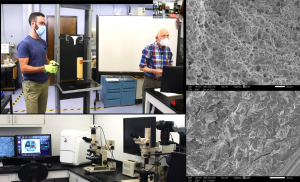 David Pope, Professor in the Department of Materials Science and Engineering, and Mark Licurse, Director of Education and Outreach at the Laboratory for Research on the Structure of Matter, taught “Failure Analysis of Engineering Materials” online during the Fall 2020 semester. They use real-world engineering examples, such as bridge collapses or construction crane failures, to help students understand why a given material has broken.
David Pope, Professor in the Department of Materials Science and Engineering, and Mark Licurse, Director of Education and Outreach at the Laboratory for Research on the Structure of Matter, taught “Failure Analysis of Engineering Materials” online during the Fall 2020 semester. They use real-world engineering examples, such as bridge collapses or construction crane failures, to help students understand why a given material has broken.
When students signed up for “Failure Analysis of Engineering Materials,” taught by David Pope, Professor in the Department of Materials Science and Engineering, and Mark Licurse, Director of Education and Outreach at the Laboratory for Research on the Structure of Matter, they were hoping to work with materials in person, examining fracture surfaces and imagining how and why materials break.
This brand-new course was to be different from how Pope and Licurse had taught materials science in the past, introducing real-world problems and how to solve them through engineering and a little detective work.
“We had designed this course to be very hands-on and expose students to real-world situations where materials fail, break or collapse, having potentially devastating consequences,” says Licurse. “We would ask students to act like detectives to figure out how and why a material had failed, showing the applicable significance of materials science and mechanical engineering.”
Many of the classes were structured around using the department’s newly acquired table-top scanning electron microscope (SEM) to look at broken pieces of materials such as metals, ceramics, glasses and polymers.
“A large portion of this course was designed around bringing material ‘corpses’ into the classroom and having students see that fracture surfaces don’t lie,” says Pope. “Access to any kind of SEM is hard to come by for undergraduate courses.”
When the pandemic shifted courses from in-person learning to online during the spring 2020 semester, Pope and Licurse were optimistic about getting back in the classroom in September. However, classes remained online and they were forced to get creative with the delivery of their course material as part of the new normal of teaching via Zoom.
Even with plenty of time to plan a fully remote course, the idea of teaching online was daunting.
“The switch from in-person to online was actually an emotional shock for us. We were designing something that we thought was a wonderful new approach to this science, and then had to limit it to an online environment,” says Pope.
Working with what they had, Pope and Licurse taught using live videos of materials breaking under stress and images of fractured surfaces under the electron microscope.

Images taken throughout the course. Counterclockwise from top left, Pope (right) and Licurse (left) demonstrate how rubber fractures under low temperatures, images of two different fractured surfaces under the scanning electron microscope (SEM), and the setup of the table-top SEM and computer monitor in the lab.
Some live demos did not go as planned, but they did help to keep the class entertaining.
“One day we were demonstrating rubber fractures at extremely low temperatures. We dipped a piece into liquid nitrogen and broke it in half. All of a sudden, a piece of frozen rubber goes flying across the room, I exclaim ‘Shoot, that one was going somewhere fast,’ and then hear David say, ‘Yeah, it hit me right in the head!’ The students all burst out laughing. You can imagine we were slightly anxious knowing our mistake had been recorded,” says Licurse.
Students were also faced with challenges when it came to connecting with their classmates.
“Sometimes it was hard to meet people in the course, especially if we had never seen their faces before, but because we were encouraged to work in teams on assignments, I was able to meet classmates through collaboration on case studies,” says Delilah Lubarsky, a student in the course.
These practical case studies were a core part of the course’s mission. Assigned as homework, they required students to think outside of formulas and equations, helping bridge students’ knowledge in theory and their real-world practice.
“When given a case study, such as the collapse of a barricade at a concert, students would frequently look for the perfect equation or formula to figure out why the material failed and who’s to blame. However, sometimes things collapse and we can’t just rely on math, and those were concepts that were hard to explain through a screen,” says Licurse.
“I did not write a single differential equation for this course, which is unusual for an engineering class,” says Pope. “We wanted this course to be truly interdisciplinary, asking students to act like detectives and think like lawyers to work through these engineering problems.”
“This course definitely taught me new things. Before taking it, I had no idea what the word ‘subrogation’ meant. Now, when I see broken materials I think about both the engineering aspects as well as how an insurance company would look for who’s to blame for the material failure,” says Kerem Sahiner, another student in the course.
To highlight this interdisciplinary approach, Pope and Licurse hosted guest speakers including lawyers, experts in crane collapse analyses, and experts in fire damage assessment, which were received surprisingly well.
“We are used to having no one ask questions at the end of a lecture, but after these guest speakers, many students had questions and were engaged with their presentations the entire time,” says Licurse.
“We even had students email us after the course was over asking about cracks in the pavement, broken tennis racket strings, and the way metal fractures under different temperatures,” says Pope.
“Now, everywhere I look, I see failed materials and can’t help myself from wondering how it broke or collapsed. I know that if I could just examine the fractured surface under a SEM, I might be able to figure out the how and why because it is true, the fractured surface doesn’t lie,” says Sahiner.
With such high student engagement in a challenging online class, what can we expect for Failure Analysis of Engineering Materials during fall 2021?
“We still plan to have an in-person course for the fall 2021 semester, but if classes remain online, we would like to improve our videography and find ways to make the photos with the SEM more interactive,” says Pope.
“Overall, I think we did accomplish a successful delivery of the course online, and it was great to see the amount of student engagement that occurred even in the less-than-ideal situation,” says Licurse.
Although the new online course environment pushed both instructors and students to learn through failure, they were happy with the course outcomes. Students enjoyed working case studies that felt realistic in the delivery and the approach of solving them with peers who may have been residing in other countries. In fact, students were grateful for the unexpected level of creativity and accessibility that this course encouraged.
“I learned a lot in this course even though it was online. I think Dr. Pope and Dr. Licurse were successful in teaching us practical problem solving through real-world case studies,” says Lubarsky. “The fact that this course had projects instead of exams also allowed students to have more fun with the material and approach it in a more realistic way. With the resources they had, this course did well virtually, but I am excited to see it as an in-person course when that happens.”
